Image above: During stormy and windy weather in late October and early November, Sable Island’s wide south beach was flooded by high waves washing over the berm. For details, see November 8, 2020 (below).
Series No.3, Zoe’s daily Facebook posts from Sable Island.
Posted on Facebook, December 12, 2020
I left Sable Island today. I had expected to be there until next week, but the wind cleared away the floodwater on an area of south beach that was suitable for a runway. As I was packing and doing last minute chores, the Northern Cardinal was having a breakfast of rose hips. I will miss him. I have appreciated your likes, comments, and engagement. Thank you all, Zoe (now in Halifax).
Posted on Facebook, December 11, 2020
In addition to beached debris, materials and equipment used by various organizations operating in the offshore are occasionally lost and washed up on Sable Island. For example, two of the Ocean Tracking Network’s underwater receivers broke free this autumn and were found on north beach and returned to OTN. An unusual item was an ammunition box found in late November. It contained five cartridge holders of 50 rounds each, Canadian military issue.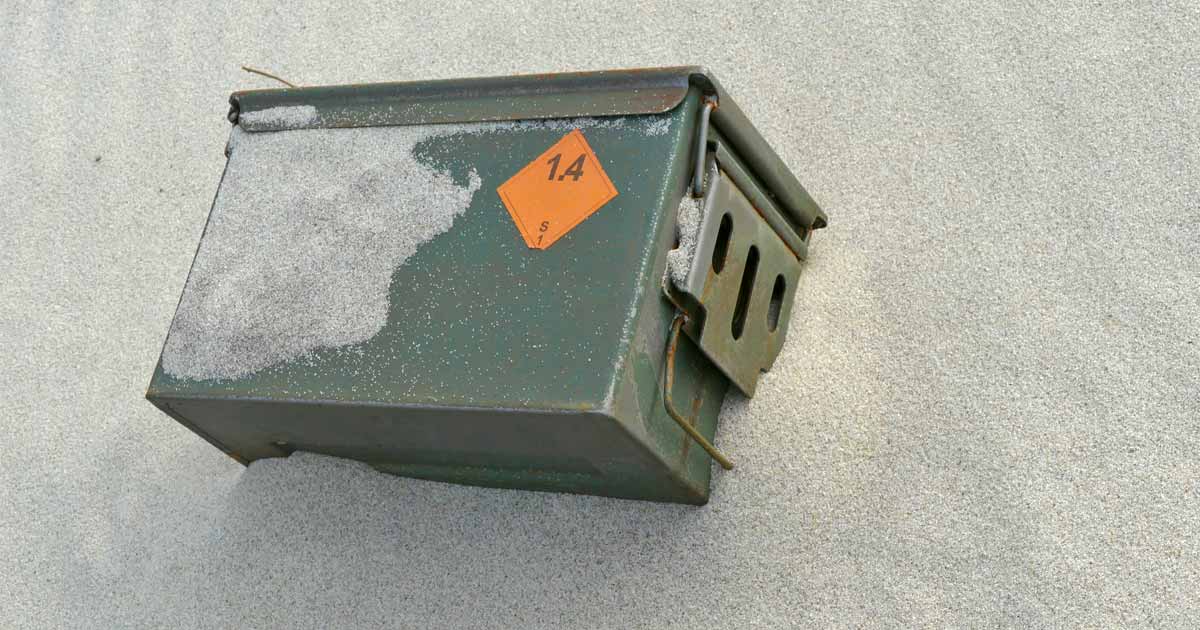
After being tumbled and tossed by the surf, half of the cartridges were loose. But the box had a tight seal; the contents were dry. The find was reported to Parks Canada and Parks contacted the Department of National Defence. DND personnel will come to the island to collect the ammunition.
Posted on Facebook, December 10, 2020
A family band of Sable Island horses is grazing in a field of marram grass with the Hummocks on the Sandy Plain in the distance. With no trees to obstruct the view, it is possible to watch the horses carry on with their daily activities undisturbed. Although the group is focused on eating, other behaviours can be observed. 
A young female (born this past spring) has one ear cocked towards the stallion grazing nearby. Still munching grass, he passes behind her and then both her ears are pointing backward towards him. Body language, or in this case, ear language suggests that she is uncomfortable or perhaps irritated, and soon after she ambles off and resumes grazing about 5 m away.

Posted on Facebook, December 9, 2020
The Sable Island Institute’s brand audit study is based on regular collections of plastic items that still have all or part of their labelling intact, and this includes plastic wrappers. Some of these can weigh less than a gram (<0.04 oz), but there are millions getting into the environment, and like all other plastic, they break up into very tiny fragments. 
Another source is the plastic labelling now commonly used on glass jars and bottles. Once in the water, the labels eventually part from the glass. The full-wrap plastic label on the vodka bottle weighs only 4 grams (roughly equal to the weight of 3 or 4 straws), but it all adds up, contributing to the pollution of the marine environment.
Posted on Facebook, December 8, 2020
These short stripes of dark sand on Sable Island’s south beach are made by amphipods flinging sand out of their burrows. They are particularly noticeable here because the amphipods are digging into a layer of heavy mineral sand. In the middle of each stripe is a small hole, about 4 to 6 mm wide. Sometimes a pair of pale blue eyes are caught looking up out of a hole, but only for a moment.

The amphipod (up to 2 cm long), commonly called a sand hopper or sand flea, is a crustacean, a group that includes animals such as crabs, lobsters, shrimps, krill, woodlice, and barnacles. It is a scavenger feeding mostly on organic debris. They are often found caught inside beached containers, and are attracted to lights at night.
Posted on Facebook, December 7, 2020
Young males on the slope of a valley carpeted with a mix of shrubs, heath, and grasses. The elevation of the lower area of the valley is about 3 m (10 ft), while the maximum height of the dune in the distance is a little over 25 m (82 ft). However, some dunes on Sable Island are nearly 30 m (98 ft) high. The complex and irregular landscape provides an abundance of locations where the horses can find shelter from the wind during storms. Much of what is known about the contemporary topography of the island is based on mapping and research conducted by the Applied Geomatics Research Group, Nova Scotia Community College (Annapolis Valley Campus).

Posted on Facebook, December 6, 2020
Although a lot of Sable Island’s history is buried, old items of wood and rusted metal sometimes appear where sand is scoured away by wind. A fragment of ornate ironwork from a stove and a deadeye have been exposed at the base of a dune slope. The wooden deadeye, probably made of lignum vitae (one of the world’s hardest woods), appears to have been used with steel cable at a site where a tower once stood. However, before that, perhaps this deadeye was part of rigging salvaged from a wrecked sailing vessel.

Spars, ribs, and ships knees are also sometimes exposed as dunes erode, but this spar washed ashore on the north beach a few years ago.
Posted on Facebook, December 5, 2020
A mild and damp day on Sable Island. The temperature reached a high of 13.4°C, a southerly wind peaked at 32 knots (59 km/h), and 2.6 mm of rain fell. As the showers soaked the vegetation, the autumn colours of foliage became more vivid and exuberant.

And the Northern Cardinal, first sighted on November 17 at West Light, is still here, adding to the seasonal abundance of reds. The cardinal, now seen daily at the Sable Island Station, is the first individual of this species recorded for the island.
Posted on Facebook, December 4, 2020
It was a sunny afternoon on Sable Island – the temperature peaked at 11°C, with a southerly wind gusting to 16 knots (30 km/h). The island’s East Light area is comprised of the decommissioned light tower, the ruins of an earlier tower, the light keeper’s residence, and traces of barns and sheds. While the skeleton of the last tower still stands on a high dune, all other structures have been buried by sand and exposed by wind, and are now mostly visible as piles and scatterings of rubble and fragments of metal, wood and glass. However, it is all of historical interest, and Parks Canada has conducted archaeological studies at the site. 
Today, a Snowy Owl had a fine view of the area from its perch high on a steep slope near the skeleton light tower.
Posted on Facebook, December 3, 2020
A pleasant day on Sable Island – mostly sunny with a light southwesterly wind (a little above and below 10 knots) and a maximum temperature of 11.7°C. A gathering of male horses socializing near a freshwater pond includes band stallions and bachelors. 
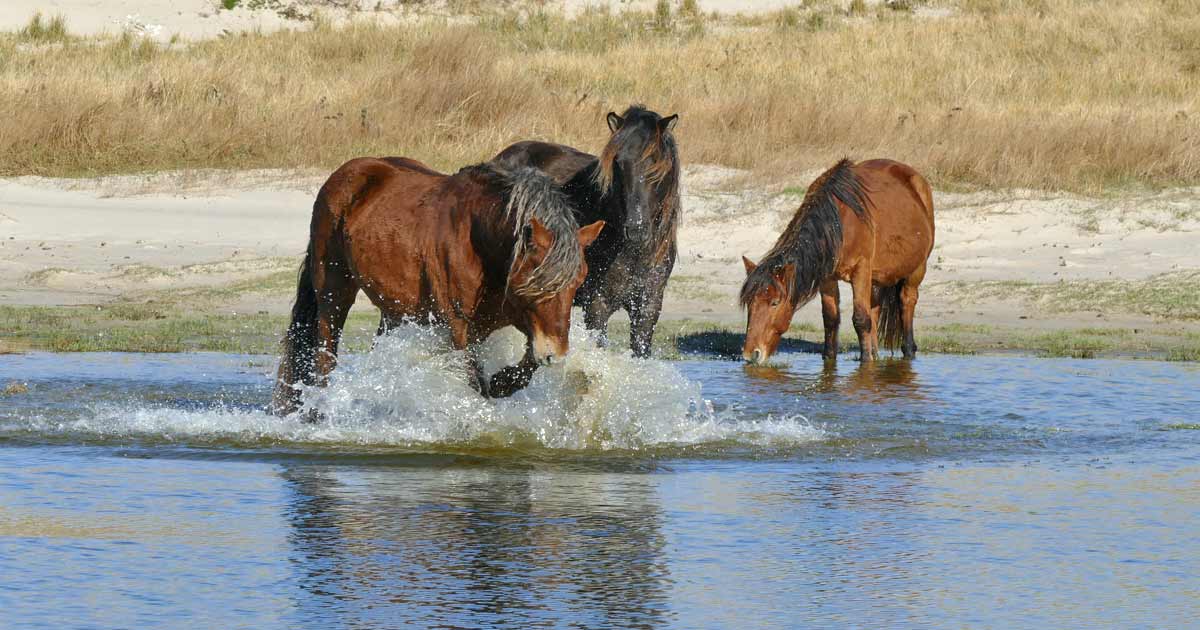
Posted on Facebook, December 2, 2020
Yesterday, on the beach near the Grey Seal mother and pup, two Sable Island horses wandered among seals resting close to the edge of the water. The horses were eating bits of vegetation washed ashore, and they found a tangle of marram grass leaves, stems and roots, still wet and salty from tumbling in the surf. Although the horses occasionally find seaweed on the beach, fragments of dune vegetation are more abundant. As dunes along the beach erode, some plant materials are carried into the sea by winds and waves, and eventually thrown back on to the beach.

The seals sometimes snarl and threaten the horses, but they are generally far less concerned than they would be if a person were nearby.
Posted on Facebook, December 1, 2020
Overcast and windy all day. Grey Seals are gathering on Sable Island for their December-January pupping and breeding season. Pregnant females are among the many thousands of seals already hauled out on the north and south beaches, and on the east and west ends of the island. Some have given birth. Grey Seal pups are born with a white coat known as lanugo, but at birth, the fur is stained a yellowish colour from amnionic fluid.

After a few days, the coat will be white and fluffy. In several weeks, the lanugo will be replaced by a coat of shorter, dark hair similar to that of the adult.
Posted on Facebook, November 30, 2020
A family band of Sable Island horses in early morning, grazing and grooming in a field of beach grass and juncus. It was calm and sunny on the island with a light breeze below 10 knots (18 km/h) for most of the day. The wind began to pick up during the evening and is forecast to be above 20 knots southeasterly tomorrow.

Posted on Facebook, November 29, 2020
A mostly sunny day on Sable Island with a brisk northwesterly wind gusting to 27 knots (50 km/h). The temperature peaked at 9.1°C this afternoon.

After walking along the edge of some remaining floodwater, the two males climbed up a steep slope to graze in a field of marram grass just inside a high south beach dune. The grass leaves are now half golden-yellow in colour and half green. These males are not part of a family band, but they are pals, and occasionally they are joined by several other males, and together they graze, visit waterholes, and rest in sunny shelter areas out of the wind.
Posted on Facebook, November 28, 2020
Another interesting visitor – a Clay-coloured Sparrow has been at the Sable Island Station for almost two weeks. It is sighted most often in or near a stand of wild rose that has formed a small thicket around a collection of driftwood and old bones.

In Canada, this species breeds from eastern British Columbia to southern Quebec, and winters mostly in Mexico, and it is a common autumn vagrant in Nova Scotia (first record in 1973). The first Clay-coloured Sparrow on Sable Island was recorded in September 1995, with several sightings since then.
Posted on Facebook, November 27, 2020
During the past few days, fragments of jellyfish have washed ashore along the north and south sides of Sable Island. Perhaps they were caught up in the rough surf. The chunks of jelly range in size from 1 to 10 cm. Many show splotches of colour, and some appear to be the remains of a species called the Purple Jellyfish or Mauve Stinger (Pelagia noctiluca). 
When photographed against a black background, a collection of the jelly scraps suggests an image taken by the Hubble Space Telescope… well, at first glance.
Posted on Facebook, November 26, 2020
A mild, damp and breezy day, with a high of 11.1°C, occasional light rain, and a southwesterly wind gusting to 18 knots (33 km/h). This afternoon on the east tip of Sable Island., there was a golden face among group of Grey Seals on the beach.

It was an albino adult male. As well as having a pale coat, his eyes, the bare skin of his nose and nostrils, and the nails (fingernails and toenails) on his flippers, were all pink or pinkish. Although not at all common, albino Grey Seals have been seen on Sable Island before, in most age groups: pup, juvenile, and adult male and female. The rusty-yellow colour of this seal’s coat is partly caused by discolouration picked up on a beach that is crowded with seals.
Posted on Facebook, November 25, 2020
Plastic water bottles, yogurt tubs, oil jugs, disposable cups & cutlery, straws, and strapping are among the 1000s of single use products that wash ashore on Sable Island. However, also abundant are plastic items that are not intended for single use. Some of these are intact and in good condition, suggesting that, rather than being discarded, they were accidental losses. Examples are baskets and bowls, decoys, hard hats, safety equipment, paddles, reusable water bottles, floats, balls, and children’s beach toys.

But no matter how they got into the ocean, once there, they are pollutants. They break into ever smaller pieces which eventually become microplastics. Except for a couple of bottle scraps and a few disposable spoons, the plastic pieces shown in the second photo, are fragments of items like those in the first photo.
Posted on Facebook, November 24, 2020
Sable Aviation flew to the island today. When Greg Stroud (Coordinator, Sable Island National Park Reserve) checked the beach this morning, he found a suitable runway – long enough, firm, and well-oriented for the westerly wind. The Britten-Norman Islander was scheduled to arrive in early afternoon, but a few hours before the flight, the strong wind, gusting to 30 knots (72 km/h), began to push floodwater towards the landing area. Parks Canada personnel, as well as the out-going passengers, dug a trench in the sand to prevent flooding of the runway.
With the Parks Canada jeep marking the runway location, the aircraft landed and parked for unloading supplies and boarding departing personnel. It was a very windy day on the beach with a lot of sand blowing about.
Posted on Facebook, November 23, 2020
At Sable Island, it was a breezy day with broken cloud cover. By afternoon, the southeasterly wind was gusting to 29 knots (54 km/h) and the temperature had risen to 11.4°C. With the low-angle sunlight occasionally gleaming on the landscape, the autumn colours of the dune vegetation ranged from the bright greens of fresh pea, poa and yarrow foliage, to the golden-brown tones of juncus and cord grass.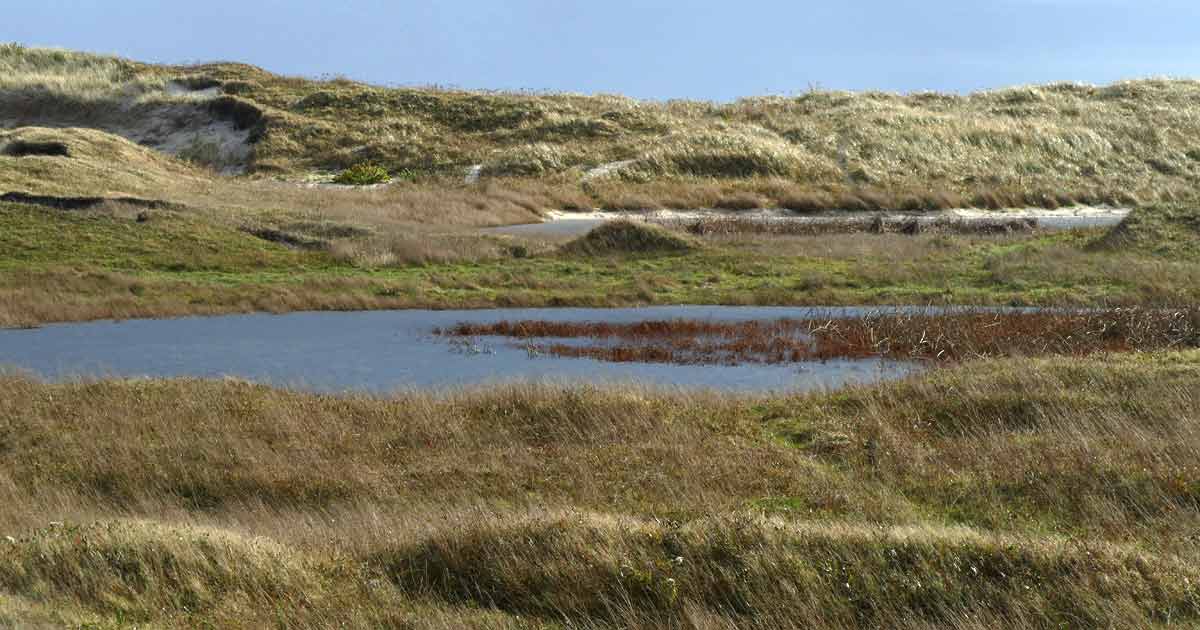

Posted on Facebook, November 22, 2020
As in cats, dogs and many other animals, grooming behaviours in horses help to keep the coat in good condition. When a horse uses its teeth or a hoof to scratch, or rolls on the ground, or rubs itself on driftwood, the activity is called autogrooming. Horses also frequently engage in mutual grooming. The young female in the middle moves over to the grazing mare and nibbles at the base of the mare’s tail. In response, the mare stops eating beach grass and gives the young female a scratch in the same area. The two horses then spend a few minutes grooming each other. Mutual grooming not only serves to manage itches in hard-to-reach places, but it is also an important social behaviour that maintains bonds between individuals.
The young female in the middle moves over to the grazing mare and nibbles at the base of the mare’s tail. In response, the mare stops eating beach grass and gives the young female a scratch in the same area. The two horses then spend a few minutes grooming each other. Mutual grooming not only serves to manage itches in hard-to-reach places, but it is also an important social behaviour that maintains bonds between individuals.

Posted on Facebook, November 21, 2020
A mild and breezy day on Sable Island, with a high of 12.9°C and southwesterly wind of 29 knots (54 km/h). A dark brown mare and her chestnut yearling are grazing in a field of grasses and beach pea while the other members of the family band are nearby and snoozing in the sunshine.

With no driftwood stumps handy to rub on, the young horse must use her teeth to scratch an itch on her chest. The yearling’s winter coat is almost fully developed.
Posted on Facebook, November 20, 2020
Sable Island’s far offshore location makes it an ideal platform for the study of marine pollutants such as plastics. Beach surveys provide information about types and sources of plastic occurring in the surrounding ocean. During these searches, items containing hazardous materials are also found: aerosol cans and plastic jugs that contain various toxic substances, including pesticides, paints, lubricants, solvents, and oils.
This jug held 2 litres of thick, black waste oil. Because it was leaking when found, the oil was drained into beached plastic bottles (always plentiful). All such containers and their contents are taken to the station for appropriate disposal. During surveys in 2019 and 2020, these collections amounted to about 60 litres of oil being removed from the beach. The survey program, led by Sable Island Institute, is conducted as part of a partnering agreement with Parks Canada.
Posted on Facebook, November 19, 2020
At sunrise, patches of white were scattered over the landscape and there were thin skins of ice at the edges of some of the freshwater ponds. The first snow cover for Sable Island was a layer of snow pellets, or graupel. The pellets and the ice didn’t last long, and by mid-morning most were gone except in well-shaded areas.

A family band of horses grazes in a field just west of the Sable Island Station, warmed in the sunshine after a chilly night with the temperature dropping to -0.2°C. By afternoon, it was warmer, getting up to 3.4°C. But with a northwesterly wind gusting to 33 knots (61 km/h), the day felt wintery.
Posted on Facebook, November 18, 2020
A cool and mostly overcast day, with a high of 6.7°C, and a northwesterly wind gusting to 22 knots (41 km/h). During the past five days, Sable Island has received 68 mm of rain. The freshwater ponds are full, and there are pools in dune hollows and slacks. The rainfall flooding in this dune slack is 10 to 20 cm deep. The slack looks gloomy in the cloud shadow, but there’s cranberry growing amongst the juncus.

Although it’s all presently under water, many of the bright red berries, still on their stems, float at the surface. The dune slacks will be wet, with varying amounts of surface water, for most of autumn and winter. 
Posted on Facebook, November 17, 2020
Three of the birds at West Light this afternoon: an endemic, a vagrant, and a rarity. The Ipswich Sparrow is an endemic because it nests only on Sable Island. After the breeding season, most migrate to their wintering grounds on the east coast. The bright yellow Prairie Warbler is regularly seen here in autumn. It is called a vagrant because when it turns up on the island, it is beyond its normal range.
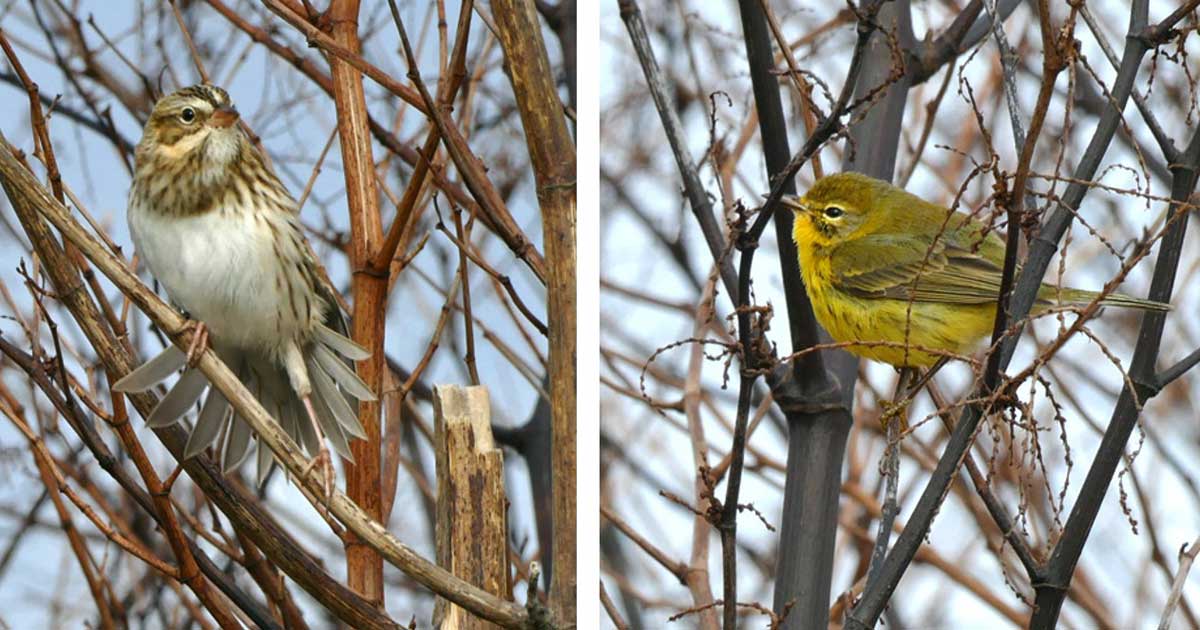
The Northern Cardinal (a male, perched on a fence wire) nests in Nova Scotia, but it is a rare bird for Sable.
Posted on Facebook, November 16, 2020
On Sable Island, the area of south beach called the Sandy Plain was a flat and featureless expanse of bare sand until about twenty-five years ago. Then embryo dunes began to form as small patches of marram grass and other plants trapped windblown sand. As the grass thrived and more sand accumulated, the new dunes increased in width and height, and in number. For years, this area was known as “The Hummocks”. The process continues.
With today’s strong southeasterly wind, gusting to 36 knots (67 km/h), sand was blown across the outer beach and into the hummocks, and every large and small vegetated dune was catching new sand as it streamed along with the wind.
Posted on Facebook, November 15, 2020
It has been a cool and breezy autumn day on Sable Island, with broken cloud and occasional showers (snow pellets in the morning), and a maximum of 8.5°C. A view from a high dune overlooking the north beach: with the strong northwesterly wind, 31 knots (57 km/h), lines of surf are rushing ashore.
On the inside slope of the same dune, in a sheltered, south-facing field of marram, horses graze and rest as waves of sunshine and shadows flow across the landscape.
Posted on Facebook, November 14, 2020
During beach surveys on Sable Island, some puzzling items have been found, for example, these bags. Since last year, eight have washed ashore, some very worn and faded, and others, such as one beached a few days ago, looking newer. They are all about 70 cm long and 30 cm wide (but their dimensions are not precisely the same), and the fabric is woven polypropylene.

Although some bags were tied closed, they were empty. When first found, they were thought to be homemade duffel bags or children’s backpacks, perhaps made from bags that had originally contained seed or animal feed. But in materials and stitching, they resemble the large metre bags used in erosion control or to hold clean-up debris.
Posted on Facebook, November 13, 2020
Driftwood is everywhere on Sable Island. Some of the large pieces of lumber, logs, branches, stumps, and broken trees that wash ashore, stay on the beach. Others end up inland when they are carried by floodwater flowing through breaks in the dune line. And occasionally, big ribs of old shipwrecks emerge from eroding slopes where sand is blown away by the wind. All these wooden shapes provide rubbing and scratching posts for the horses. Strands and tangles of horse hair are caught in the cracks, and the most rubbed-upon surfaces are polished. A young male enjoys a neck massage until an older member of the group moves in for a scratch.

Posted on Facebook, November 12, 2020
A soggy but mild day on Sable Island with about 14 mm of rain and a maximum temperature of 14.9°C. The wind was again southwesterly and gusting to 27 knots. During stormier weather, the high dunes, steep slopes, and hollows provide shelter from the wind for the horses. There’s no protection from the rain, but in these shelter areas, the horses can be less exposed to blowing sand and chilling effect of the wind.
Even though it was overcast and gloomy all day, the rain brightened the fall colours of the island’s plants, such as Seaside Goldenrod.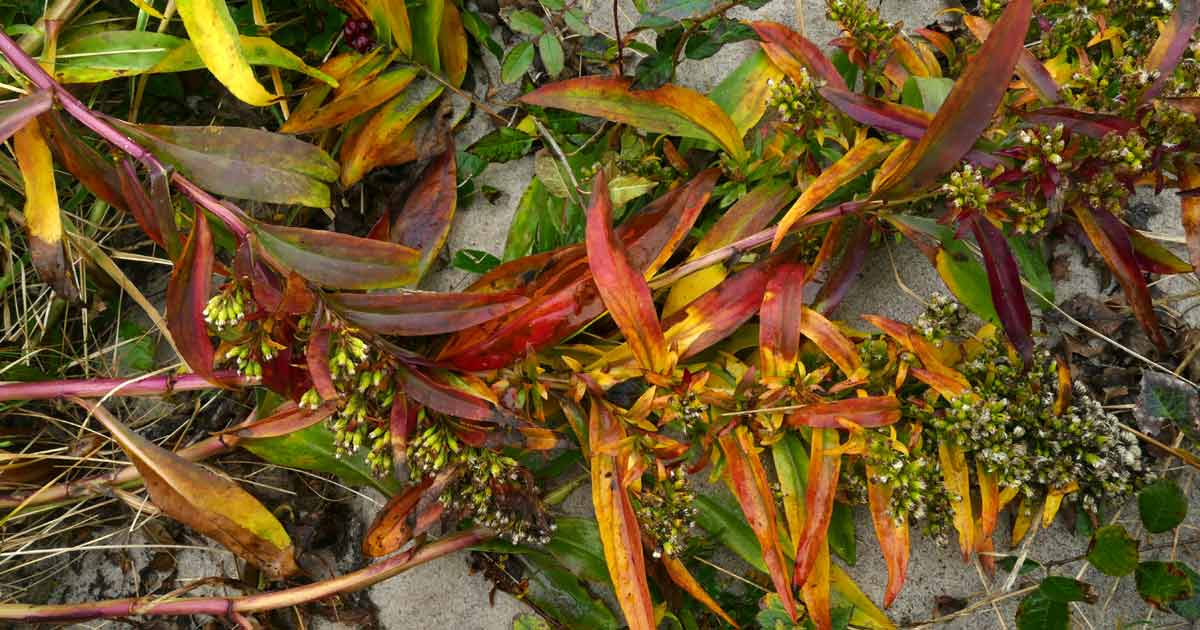
Posted on Facebook, November 11, 2020
November 11, 2020, Remembrance Day. On Sable Island the temperature was between 12 and 13°C with 100% humidity and fog or mist for most of the day. There was a very brief burst of rain in the morning, and the southwesterly wind peaked at 27 knots (50 km/h). Wave height in the Sable area was less than 2 m, and there wasn’t much surf along the north beach. It was peaceful.

Posted on Facebook, November 10, 2020
The day began in thick fog, but by afternoon the fog had dissipated, and the sky was mostly clear. The temperature was between about 10 and 12°C, with a southwesterly breeze of 19 knots (35 km/h). While Grey Seals in the surf watched a person conducting a survey along the beach, a Sable Island stallion rested on a windy dune slope, perhaps contemplating the landscape or a few groups of horses in the distance.

Posted on Facebook, November 9, 2020
On May 1, the SSCV Thialf arrived in the Sable Island area to begin removal of the topsides and underwater support structures of the offshore platforms, the final stage in the decommissioning of the Sable Offshore Energy Project. In a view from the beach on July 2, the huge Thialf (the second largest crane vessel in the world) towered over the Thebaud platform, 10 km southwest of the island.

Early this morning, having completed the removal of the last platform, Venture, the Thialf was towed by the offshore supply vessel Atlantic Kestrel, and headed for Chedabucto Bay. It could be seen from the Sable Island Station as it passed the island (with MSC’s anemometer in the foreground). So ends an era. The offshore energy industry has been a presence here for many decades, and it has been a part of the Sable Island community.
Posted on Facebook, November 8, 2020
During the past few weeks of stormy and windy weather, Sable Island’s wide south beach areas known as Wallace Flats and the Sandy Plain were flooded by high waves washing over the berm. When not under water, the beach is used as a landing strip for the fixed-wing aircraft. So, some flights had to be cancelled and others were made by helicopter.

Eventually the flooding retreats, frequently draining off through a “river”, a cut that forms across the berm and allows floodwater to flow back into the ocean. Sometimes the river is broad and rushing like wild rapids, or, like the river today, it is more of a shallow but steady stream. The dark patches on the beach are accumulations of heavy mineral sands.
Zoe Lucas, Sable Island Institute
November 8 – December 12, 2020
For Zoe’s other series of Facebook posts, see:
Series No.1, Posted on Facebook, June 8 – July 11, 2020
Series No.2, Posted on Facebook, October 9 – November 7, 2020
Series No.4, Posted on Facebook, October 26 – November 28, 2021

